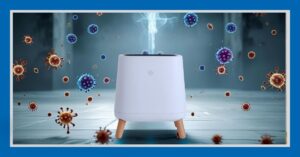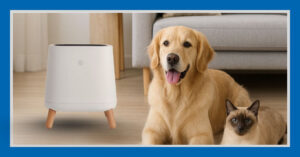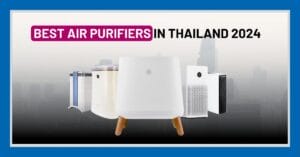Your cart is currently empty!

How Do Air Purifiers Work?
by Peemanus Tongpiem / January 25, 2024
Air purifiers have taken Thailand by storm, where combating PM2.5 is a top priority.
But how do air purifiers work, allowing us to breathe clean air at home despite outside smog? Did you know that various types of air purifiers exist, each operating in a slightly different way?
Read on to get a clear understanding of air purifiers and their role in combating air pollution.
So, HOw do air purifiers work?
Air purifiers work by using a fan to draw in dirty air and push it through a HEPA filter, which traps pollutants. The clean air is then released back into the environment. This simple process effectively removes contaminants like PM2.5, viruses, bacteria, and other pollutants.
What Are Air Purifiers Made From?
To understand how air purifiers work we should open one first to see what’s inside.
To the left is the Sqair air purifier. On the right, you see it broken down into its separate components.

It’s pretty simple: it has a fan and a HEPA filter.
Now, let’s check out the IQAir air purifier. It’s pricey at $2,000, about 20 times more than the Sqair.

Surprise! It’s the same inside. The IQAir also has fans and filters. This is true for all air purifiers, no matter the brand.
Whether they cost $100 or $2,000, every air purifier is made up of just a fan and a filter. That’s all there is to it.
What Does an Air Purifier Do?
Alright, now that we know what’s in air purifiers, let’s see how they work.
In short: It’s really simple.
The fan sucks in dirty air and pushes it through the HEPA filter. This filter traps pollutants. Then, clean air comes out.

Read more: What is a HEPA filter?
It’s a pretty straightforward-forward process. According to NASA, HEPA air purifier filters trap up to 100% of airborne pollutants.
This includes all kinds of contaminants such as:

Just so you know, pricey air purifiers aren’t always the best. A lot of cheaper models work better than the expensive ones.
When choosing an air purifier, don’t just focus on the price.
Check the datasheet first and look for the CADR rating (Clean Air Delivery Rate). The CADR is every air purifier’s most important number and tells you how powerful the device is.
After doing a bit of research, you might be surprised to find that many expensive brands don’t do as well as cheaper ones.
Read more: What are the best air purifiers available?
What Other Types of Air Purifiers Exist and How Do They Work?
HEPA air purifiers as described above are the most popular units available. Their effectiveness has been proven for years and the scientific evidence is pretty conclusive.
But there are also other ways of purifying the air. What are these?
Air Purifiers With Carbon Filters
HEPA filters catch solid stuff like dust, while activated carbon filters grab gases (TVOCs) and smell from the air.
Activated carbon filters have tiny charcoal bits that soak up chemicals from the air.
For full protection from air pollution, it’s best to use both HEPA and activated carbon filters. A lot of air purifiers already have both kinds.

Air Purifiers With Ionizers
In the last decade, lots of companies started adding ionizers to their air purifiers.
Ionizers release negative ions that stick to dust and other pollutants, which usually have a positive charge. This makes the dust settle on surfaces like desks or floors.

Unlike HEPA filters, ionizers don’t trap dust. They just move it to other places.
There are two big problems with ionizers:
- They can make things dirty, as the dust just sticks to stuff around the room.
- Some ionizers cause ozone, which isn’t good for our lungs. A University of Texas study found that ionizers can even create PM2.5.
With this in mind, we wouldn’t suggest air purifiers using ionizers. HEPA air cleaners alone are usually enough.

Air Purifiers With UV Lights
During the COVID-19 pandemic, air purifiers with UV lights got popular.
These purifiers use UV lights to fight viruses. But they might not work as well as you think.
UV lights can inactivate germs like bacteria and viruses, but the ones in air purifiers are often too weak to do much.
This is because a really strong UV can hurt us, like when you get a sunburn.
Also, some UV air purifiers make Ozone, just like ionizers. That’s why the EPA doesn’t recommend them.

Bottom Line
- Simplicity in Design: Air purifiers consist fundamentally of a fan and a HEPA filter, regardless of brand or price.
- Effectiveness: They are effective in trapping up to 100% of airborne pollutants, including fine dust, viruses, and bacteria.
- Price vs. Performance: Expensive air purifiers are not always superior; it’s crucial to check the CADR rating rather than just the price.
- Technological Variations: While HEPA and carbon filters are standard, some purifiers also use ionizers or UV lights, but their effectiveness and safety (due to ozone production) can vary.

Peemanus Tongpiem
เราให้ความสำคัญกับอาหารที่เรารับประทาน 3 มื้อต่อวัน แต่เรากลับละเลยอากาศที่เราใช้หายใจมากกว่า 10 ครั้งต่อนาที เป็นเหตุให้ผมเริ่มค้นคว้าและเผยแพร่ความรู้เรื่องมลพิษทางอากาศ เพื่อให้ผู้คนตระถึงความสำคัญของการใช้เครื่องฟอกอากาศเพื่อสุขภาพที่ดีขึ้น







